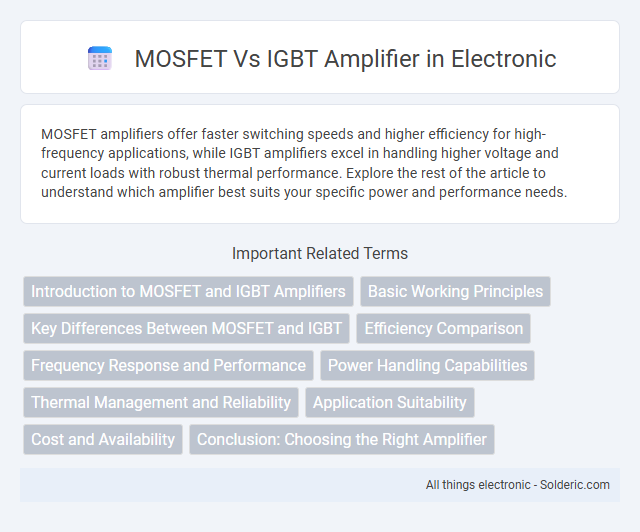MOSFET amplifiers offer faster switching speeds and higher efficiency for high-frequency applications, while IGBT amplifiers excel in handling higher voltage and current loads with robust thermal performance. Explore the rest of the article to understand which amplifier best suits your specific power and performance needs.
Comparison Table
| Feature | MOSFET Amplifier | IGBT Amplifier |
|---|---|---|
| Switching Speed | High speed, suitable for high-frequency applications | Moderate speed, slower than MOSFET |
| Conduction Loss | Lower conduction losses at low voltages | Higher conduction losses but better at high voltages |
| Voltage Rating | Typically up to 250V to 600V | High voltage capability, typically 600V to 6500V |
| Current Handling | Limited by channel width, good for low to medium currents | High current handling capacity |
| Thermal Performance | Better thermal conduction and lower thermal resistance | Good thermal stability but higher losses increase heat |
| Drive Complexity | Voltage driven, simpler gate drive | Voltage driven but requires careful switching control |
| Applications | Audio amplifiers, RF amplifiers, low-voltage inverters | Power electronics, motor drives, high power inverters |
| Cost | Generally lower cost for low power applications | Higher cost but cost-effective for high power |
Introduction to MOSFET and IGBT Amplifiers
MOSFET amplifiers utilize metal-oxide-semiconductor field-effect transistors to achieve high switching speeds and efficient voltage control, making them ideal for high-frequency applications. IGBT amplifiers combine the high input impedance of MOSFETs with the high current-carrying capability of bipolar transistors, offering superior performance in high-power and high-voltage scenarios. The choice between MOSFET and IGBT amplifiers depends on application-specific parameters like switching frequency, power level, and thermal performance requirements.
Basic Working Principles
MOSFET amplifiers operate by controlling voltage at the gate terminal to regulate current flow between the drain and source, exploiting the device's high input impedance and fast switching capabilities. IGBT amplifiers combine MOSFET input characteristics with bipolar transistor output properties by using a gate voltage to control a conductive channel, enabling efficient handling of high voltage and current levels. The fundamental distinction lies in MOSFETs being majority carrier devices suited for high-frequency operation, while IGBTs act as bipolar devices optimized for high-power switching with lower conduction losses.
Key Differences Between MOSFET and IGBT
MOSFETs offer faster switching speeds and higher efficiency in amplifiers, making them ideal for high-frequency applications. IGBTs excel in handling higher voltage and current, providing better performance in high-power and medium-frequency scenarios. Your choice between MOSFET and IGBT amplifiers depends on the specific requirements of switching speed, voltage, and power ratings.
Efficiency Comparison
MOSFET amplifiers generally offer higher efficiency at high switching frequencies due to lower gate charge and faster switching speeds compared to IGBT amplifiers. IGBTs excel in high voltage and high current applications but typically exhibit higher conduction losses and switching losses, reducing overall efficiency in fast-switching scenarios. Your choice between MOSFET and IGBT amplifiers should consider the specific frequency and power requirements to optimize efficiency.
Frequency Response and Performance
MOSFET amplifiers excel in high-frequency response thanks to their low gate charge and fast switching capabilities, making them ideal for applications requiring rapid signal amplification. IGBT amplifiers, while offering higher current and voltage handling, typically exhibit slower switching speeds, resulting in lower frequency performance compared to MOSFETs. Your choice between the two should consider the required frequency range and efficiency, with MOSFETs favored for high-frequency precision and IGBTs suited for high-power applications at moderate frequencies.
Power Handling Capabilities
MOSFET amplifiers excel in high-frequency applications due to their fast switching speeds and low gate drive power, making them suitable for handling moderate power levels efficiently. IGBT amplifiers offer superior power handling capabilities in high-voltage and high-current environments, commonly used in industrial and heavy-duty power electronics. Your choice between MOSFET and IGBT amplifiers depends on the specific power requirements and switching frequency of your application.
Thermal Management and Reliability
MOSFET amplifiers offer superior thermal conductivity and faster switching speeds, reducing heat buildup and enhancing overall thermal management compared to IGBT amplifiers. IGBT amplifiers typically handle higher voltage applications but generate more heat, requiring robust cooling systems to maintain reliability. Optimizing your amplifier's thermal design with effective heat sinks and cooling mechanisms ensures longevity and consistent performance in demanding environments.
Application Suitability
MOSFET amplifiers excel in high-frequency applications and low-voltage circuits due to their fast switching speed and high input impedance, making them ideal for RF and audio amplification. IGBT amplifiers are better suited for high-power, high-voltage applications like industrial motor drives and power inverters, benefiting from their robustness and efficiency in handling large current loads. Your choice depends on whether the application prioritizes switching frequency or power handling capabilities.
Cost and Availability
MOSFET amplifiers generally cost less due to simpler manufacturing processes and widespread semiconductor use, leading to high availability in various power ranges. IGBT amplifiers tend to be more expensive because of complex fabrication and specialized applications, but they offer superior performance in high-voltage and high-current conditions. Market availability of MOSFETs is broader for low-to-mid power amplifiers, whereas IGBTs dominate niche markets requiring robust handling of heavy loads.
Conclusion: Choosing the Right Amplifier
Choosing the right amplifier depends on the application requirements, where MOSFET amplifiers excel in high-frequency, low-voltage scenarios due to faster switching speeds and lower gate charge. IGBT amplifiers are preferred for high-power, high-voltage applications because of their robustness and efficiency in handling larger currents. Evaluating factors such as switching speed, voltage ratings, efficiency, and thermal performance is crucial to optimize amplifier design and performance.
MOSFET vs IGBT amplifier Infographic

 solderic.com
solderic.com